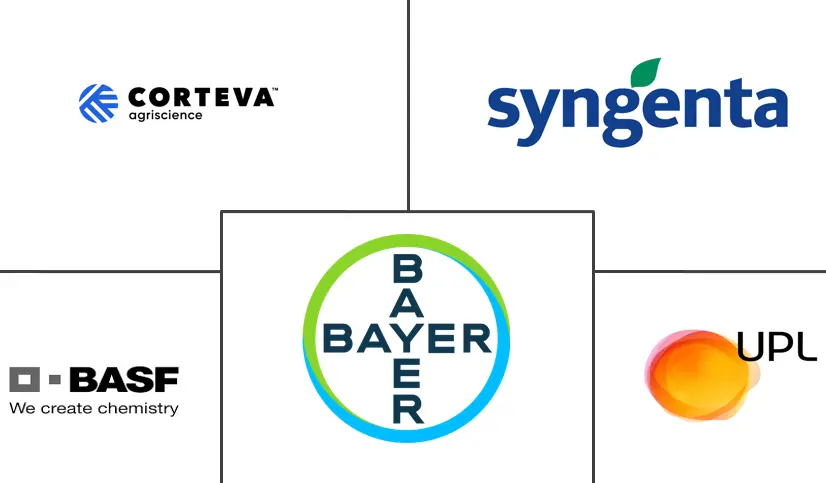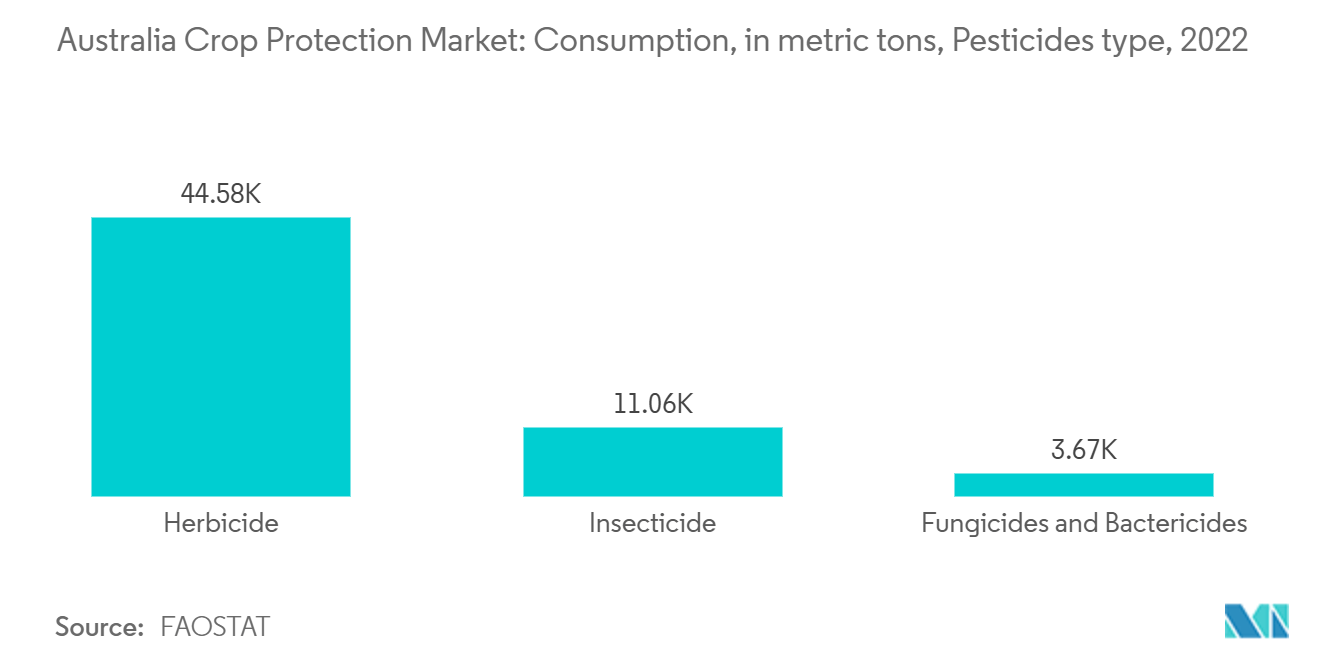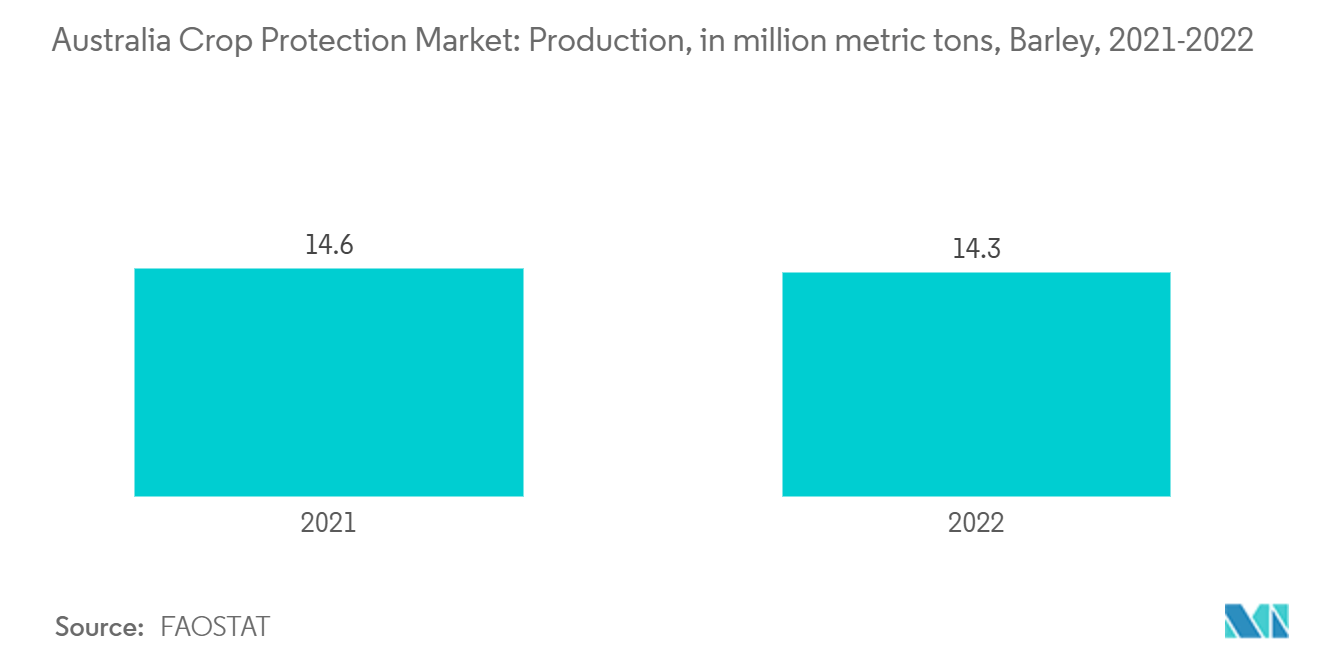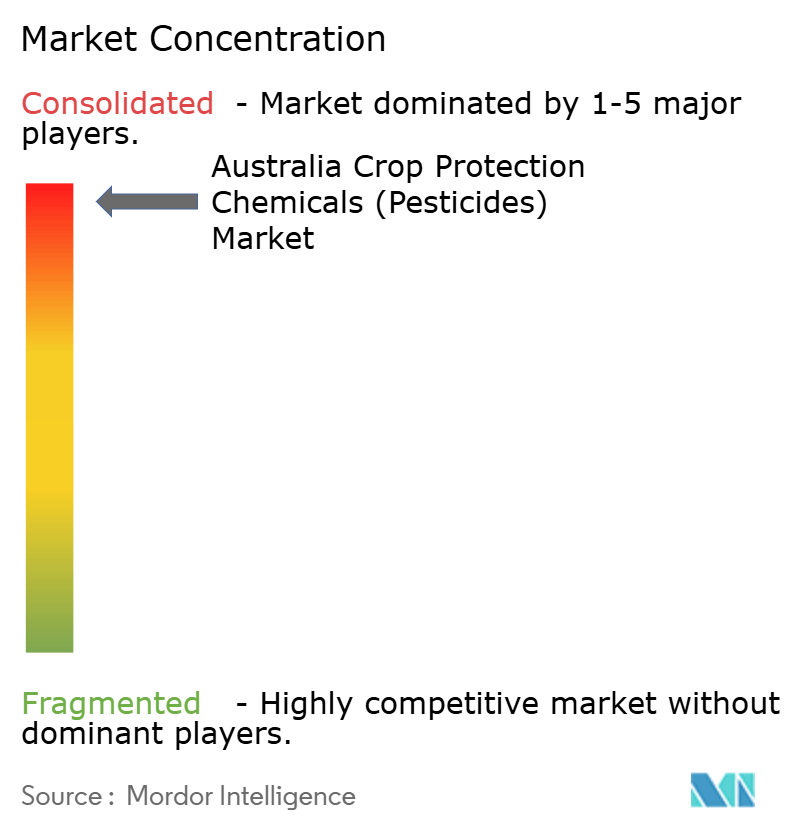Australia Crop Protection Chemicals (Pesticides) Market Size

| Study Period | 2019 - 2029 |
| Base Year For Estimation | 2023 |
| Market Size (2024) | USD 1.98 Billion |
| Market Size (2029) | USD 2.64 Billion |
| CAGR (2024 - 2029) | 5.90 % |
| Market Concentration | High |
Major Players
*Disclaimer: Major Players sorted in no particular order |
Australia Crop Protection Pesticides Market Analysis
The Australia Crop Protection Chemicals Market size is estimated at USD 1.98 billion in 2024, and is expected to reach USD 2.64 billion by 2029, at a CAGR of 5.90% during the forecast period (2024-2029).
The crop protection market in Australia is crucial for the agricultural sector, focusing on pest management and boosting overall productivity. The market has grown steadily in recent years due to rising food demand and the need to maximise yields from extensive cultivated lands. The Australian Bureau of Statistics reported that the crop production area in Australia increased from 25.2 million hectares to 25.6 million hectares in 2022. This growth in agricultural land reflects the need to meet the rising food demand, leading to higher demand for efficient pest control and fertilization methods. Additionally, the introduction and spread of non-native pests and diseases, such as the fall armyworm or the red imported fire ant, drive the need for more pesticides to protect crops in Australia.
Moreover, government support significantly contributes to market growth. The Australian Government has allocated USD 25.7 million over eleven years (2014-2025) to help farmers access safe and effective agricultural and veterinary (agvet) chemicals, aiding food production for Australia and the world. Additionally, the crop protection chemicals market is becoming a key factor in enhancing agricultural productivity in the country. However, overuse and reliance on respective chemicals have led to resistance in weeds and insects, necessitating the use of more potent crop protection chemicals. This situation has increased the adoption of biological crop protection products in the country. Therefore, the growing demand, coupled with government support and the rising importance of bio-based crop protection products, is driving market growth during the forecast period.
Australia Crop Protection Pesticides Market Trends
Herbicides dominated the Australia Crop Protection Chemicals Market
- Weeds pose a major biosecurity challenge to Australian crops, leading to reduced yields and significant financial losses for producers. Consequently, the demand for herbicides has surged, making them the dominant segment in Australia's crop protection chemicals market. For instance, as of 2024, the Australian Bureau of Agricultural and Resource Economics reported that out of roughly 3,207 introduced plant species that have naturalized in Australia, around 500 have been classified as noxious or are under legislative control. Furthermore, a notable shortage of farm labor, particularly for manual tasks like weeding, has emerged. Herbicides present an efficient means to manage weeds, minimizing the need for extensive human labor, thus becoming increasingly appealing to farmers. For instance, data from the World Bank indicates that in 2022, agricultural employment in Australia constituted 2.20% of total employment, down from 2.49% in 2021. This decline in agricultural labour has spurred the rising reliance on herbicides. According to FAO, in 2022, Australia utilized 44,580 metric tons of herbicides, outpacing insecticide usage at 11,059 metric tons and fungicides and bactericides at 3,672 metric tons.
- Furthermore, advancements in targeted herbicide formulations and application technologies, such as precision agriculture, have enhanced the effectiveness and ease of herbicide application. This trend is particularly pronounced among larger commercial farmers. For instance, in June 2024, Bayer introduced the XtendFlex herbicide tolerance technology in XtendFlex cotton for commercial use in Australia. They also secured approval for the XtendiMax 2 Herbicide with VapourGrip Technology for over-the-top application, providing Australian cotton growers with enhanced flexibility in their weed management approaches. Collectively, these dynamics underscore the escalating demand for herbicides in Australia, positioning them as indispensable tools for bolstering agricultural productivity and addressing weed-related challenges.

Increasing Usage of Pesticides in Cereals and Grains
- Cereals play a vital role in Australia's healthy diet. Australia cultivates major cereals, including wheat, barley, oats, canary, and triticale. However, these crops face threats from common pests like cutworms, armyworms, mites, Helicoverpa, and aphids, leading to yield losses. Barley, like other cereals, is susceptible to various insect pests, with aphids being the primary concern in Australia's northern growing region. Research indicates that aphid feeding significantly reduces barley yields in this area. For example, FAO data shows barley production in Australia fell from 14.6 million metric tons in 2021 to 14.3 million metric tons in 2022. This year-on-year decline in barley and other cereals, attributed to pest damage, is driving an increased demand for crop protection chemicals, thus fueling market growth.
- Supportive initiatives promoting natural crop protection products are significantly driving market growth. In 2022, Cesar Australia, in collaboration with the University of Melbourne and backed by the Grains Research and Development Corporation, unveiled a new tool. This initiative was part of the Australian Grains Pest Innovation Program (AGPIP). The tool aids Australian grain growers by providing a chemical toxicity table for beneficial insects, enhancing on-farm decision-making. This toxicity table details the effects of commonly used pesticides on key beneficial insect groups, which can naturally control pests. Consequently, as cereal production declines due to pest attacks and there's a growing preference for natural crop protection, the market is poised for growth during the forecast period.

Australia Crop Protection Industry Overview
The crop protection chemicals market in Australia is consolidated, with major players, including Syngenta International AG, Bayer CropScience AG, Corteva AgriScience, BASF SE, and UPL Limited, accounting for major share in the market. New product launches, mergers and acquisitions, and partnerships are the major strategies these leading companies adopt in the market. These companies also focus on investing in innovations, collaborations, and expansions to increase their market share.
Australia Crop Protection Market Leaders
-
Syngenta AG
-
Bayer Crop Science AG
-
BASF SE
-
Corteva Agriscience
-
UPL Limited
*Disclaimer: Major Players sorted in no particular order

Australia Crop Protection Market News
- September 2024: Albaugh, a global leader in crop protection solutions, has officially registered its SPIROMAX 240 SC Insecticide in Australia. This achievement underscores Albaugh's expansion into the Australian agricultural market and reaffirms our dedication to delivering high-quality and cost-effective crop protection products to Australian farmers.
- May 2024: BASF has introduced its innovative insecticide, Cimegra, in Australia. This product features a new active ingredient, Broflanilide, developed using BASF's proprietary technology. Cimegra offers robust and prolonged protection against resilient insect pests, catering to a diverse range of crops.
- January 2023: BASF has launched Axalion Active, a novel insecticide ingredient aimed at controlling harmful piercing and sucking insect pests in Australia. Axalion-containing products are suitable for use on a wide range of crops, including fruits, vegetables, soybeans, legumes, cotton, cereals, beets, oilseed rape, and ornamentals.
Australia Crop Protection Chemicals (Pesticides) Market Report - Table of Contents
1. INTRODUCTION
1.1 Study Assumptions & Market Definition
1.2 Scope of the Study
2. RESEARCH METHODOLOGY
3. EXECUTIVE SUMMARY
4. MARKET DYNAMICS
4.1 Market Overview
4.2 Market Drivers
4.2.1 Increasing Demand for Food
4.2.2 Rising Innovation and Development
4.2.3 Growing popularity of Biopesticides
4.3 Market Restraints
4.3.1 High Cost of R&D
4.3.2 Stringent Regulatory Landscape
4.4 Porter's Five Forces Analysis
4.4.1 Bargaining Power of Suppliers
4.4.2 Bargaining Power of Buyers/Consumers
4.4.3 Threat of Substitute Products
4.4.4 Threat of New Entrants
4.4.5 Intensity of Competitive Rivalry
5. MARKET SEGMENTATION
5.1 Function
5.1.1 Herbicide
5.1.2 Fungicide
5.1.3 Insecticide
5.1.4 Nematicide
5.1.5 Molluscicide
5.2 Application Mode
5.2.1 Chemigation
5.2.2 Foliar
5.2.3 Fumigation
5.2.4 Seed Treatment
5.2.5 Soil Treatment
5.3 Crop Type
5.3.1 Commercial Crops
5.3.2 Fruits and Vegetables
5.3.3 Grains and Cereals
5.3.4 Pulses and Oilseeds
5.3.5 Turf and Ornamentals
6. COMPETITIVE LANDSCAPE
6.1 Most Adopted Strategies
6.2 Market Share Analysis
6.3 Company Profiles
6.3.1 Bayer CropScience AG
6.3.2 Syngenta International AG
6.3.3 BASF SE
6.3.4 Corteva Agriscience
6.3.5 UPL Limited
6.3.6 ADAMA Agricultural Solutions
6.3.7 FMC Corporation
6.3.8 Nufarm Ltd
6.3.9 Sumitomo Chemicals
6.3.10 American Vanguard Corporation
7. MARKET OPPORTUNITIES AND FUTURE TRENDS
Australia Crop Protection Pesticides Industry Segmentation
Crop protection chemicals, also known as pesticides, are chemicals used to protect crops from pests and diseases. Pesticides are used to control a variety of agricultural pests that damage crops and reduce farm productivity. The Australia Crop Protection Chemicals Market is segmented Function (Fungicide, Herbicide, Insecticide, Molluscicide, Nematicide), Application Mode (Chemigation, Foliar, Fumigation, Seed Treatment, Soil Treatment) and Crop Type (Commercial Crops, Fruits & Vegetables, Grains & Cereals, Pulses & Oilseeds, Turf & Ornamental). The report also offers the market sizing and forecastss in terms of value (USD) and volume (metric tons).
| Function | |
| Herbicide | |
| Fungicide | |
| Insecticide | |
| Nematicide | |
| Molluscicide |
| Application Mode | |
| Chemigation | |
| Foliar | |
| Fumigation | |
| Seed Treatment | |
| Soil Treatment |
| Crop Type | |
| Commercial Crops | |
| Fruits and Vegetables | |
| Grains and Cereals | |
| Pulses and Oilseeds | |
| Turf and Ornamentals |
Australia Crop Protection Chemicals (Pesticides) Market Research Faqs
How big is the Australia Crop Protection Chemicals Market?
The Australia Crop Protection Chemicals Market size is expected to reach USD 1.98 billion in 2024 and grow at a CAGR of 5.90% to reach USD 2.64 billion by 2029.
What is the current Australia Crop Protection Chemicals Market size?
In 2024, the Australia Crop Protection Chemicals Market size is expected to reach USD 1.98 billion.
Who are the key players in Australia Crop Protection Chemicals Market?
Syngenta AG, Bayer Crop Science AG, BASF SE, Corteva Agriscience and UPL Limited are the major companies operating in the Australia Crop Protection Chemicals Market.
What years does this Australia Crop Protection Chemicals Market cover, and what was the market size in 2023?
In 2023, the Australia Crop Protection Chemicals Market size was estimated at USD 1.86 billion. The report covers the Australia Crop Protection Chemicals Market historical market size for years: 2019, 2020, 2021, 2022 and 2023. The report also forecasts the Australia Crop Protection Chemicals Market size for years: 2024, 2025, 2026, 2027, 2028 and 2029.
Australia Crop Protection Chemicals (Pesticides) Industry Report
The report on Australia Crop Protection Pesticides Manufacturers provides a comprehensive industry analysis, focusing on synthetic and bio-based origins. It covers various types of pesticides, including herbicides, insecticides, fungicides, nematicides, molluscicides, and other types. The market segmentation is based on applications such as grains and cereals, pulses and oilseeds, fruits and vegetables, commercial crops, and other applications. The industry outlook is positive, with significant market growth anticipated.
The market overview highlights the market trends and the industry growth. Detailed market data and market value provide insights into the industry's performance. The market forecast and market predictions suggest continued expansion, supported by the industry's robust market segmentation. Industry research indicates that market leaders and research companies are driving innovation and efficiency in crop protection.
The report pdf offers a detailed market review and industry statistics, essential for understanding the market size and industry size. The industry reports include comprehensive industry information and market analysis, which are crucial for stakeholders. The report example provides a clear understanding of the industry's dynamics, while the market outlook and industry trends offer a glimpse into future developments.
The industry's growth rate is supported by extensive industry research and market data, ensuring that the market value remains strong. The market segmentation and market overview provide a clear picture of the industry's structure. The industry reports and market forecast highlight the market's potential, while the industry sales and market growth reflect the industry's economic impact.
In conclusion, the report provides a thorough market review, supported by detailed industry statistics and market predictions. The market outlook is promising, with significant market growth expected. The report pdf and report example offer valuable insights into the industry's current state and future prospects.



